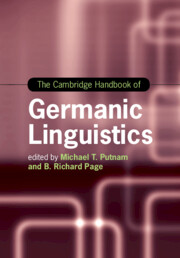Book contents
- The Cambridge Handbook of Germanic Linguistics
- Cambridge Handbooks in Language and Linguistics
- The Cambridge Handbook of Germanic Linguistics
- Copyright page
- Contents
- Figures
- Maps
- Tables
- Contributors
- Acknowledgments
- Germanic Languages
- Part I Phonology
- Part II Morphology and Agreement Systems
- Part III Syntax
- Chapter 15 VO-/OV-Base Ordering
- Chapter 16 The Placement of Finite Verbs
- Chapter 17 Germanic Infinitives
- Chapter 18 The Unification of Object Shift and Object Scrambling
- Chapter 19 Unbounded Dependency Constructions in Germanic
- Chapter 20 The Voice Domain in Germanic
- Chapter 21 Binding
- Chapter 22 Verbal Particles, Results, and Directed Motion
- Chapter 23 Structure of Noun (NP) and Determiner Phrases (DP)
- Part IV Semantics and Pragmatics
- Part V Language Contact and Nonstandard Varieties
- Index
- References
Chapter 19 - Unbounded Dependency Constructions in Germanic
from Part III - Syntax
Published online by Cambridge University Press: 31 March 2020
- The Cambridge Handbook of Germanic Linguistics
- Cambridge Handbooks in Language and Linguistics
- The Cambridge Handbook of Germanic Linguistics
- Copyright page
- Contents
- Figures
- Maps
- Tables
- Contributors
- Acknowledgments
- Germanic Languages
- Part I Phonology
- Part II Morphology and Agreement Systems
- Part III Syntax
- Chapter 15 VO-/OV-Base Ordering
- Chapter 16 The Placement of Finite Verbs
- Chapter 17 Germanic Infinitives
- Chapter 18 The Unification of Object Shift and Object Scrambling
- Chapter 19 Unbounded Dependency Constructions in Germanic
- Chapter 20 The Voice Domain in Germanic
- Chapter 21 Binding
- Chapter 22 Verbal Particles, Results, and Directed Motion
- Chapter 23 Structure of Noun (NP) and Determiner Phrases (DP)
- Part IV Semantics and Pragmatics
- Part V Language Contact and Nonstandard Varieties
- Index
- References
Summary
Unbounded Dependency Constructions in Germanic are a particular fruitful area for the exploration of the nature of A’-movement because this language family shows an intriguing array of options to form such dependencies. In this survey, I will first introduce the major functions of canonical unbounded dependencies involving a filler-gap dependency (wh-movement, topicalization, relativization), focusing on their shared properties (sensitivity to locality, successive-cyclic movement) and differences (shape of the left periphery, presence/absence of subject-verb inversion, nature of the landing site) both within individual languages and cross-linguistically. After addressing asymmetries between local and long-distance dependencies, I discuss alternatives to canonical long-distance movement such as extraction from verb second clauses (which is sometimes treated as involving a parenthetical), scope marking / partial movement, wh-copying and A’-dependencies that terminate in a pronoun rather than a gap (resumption, prolepsis). In the last part I provide an overview of locality-related issues that are particularly striking in this language family such as the clause-boundedness of A’-movement in German, the variable strength of topic and wh-islands, the (putative) absence of strong island effects in Scandinavian, and variation in that-trace effects.
Keywords
- Type
- Chapter
- Information
- The Cambridge Handbook of Germanic Linguistics , pp. 436 - 460Publisher: Cambridge University PressPrint publication year: 2020



